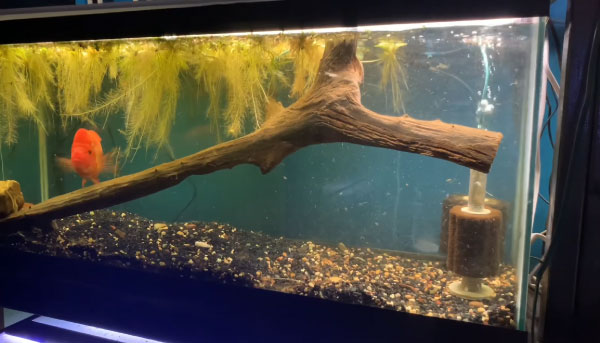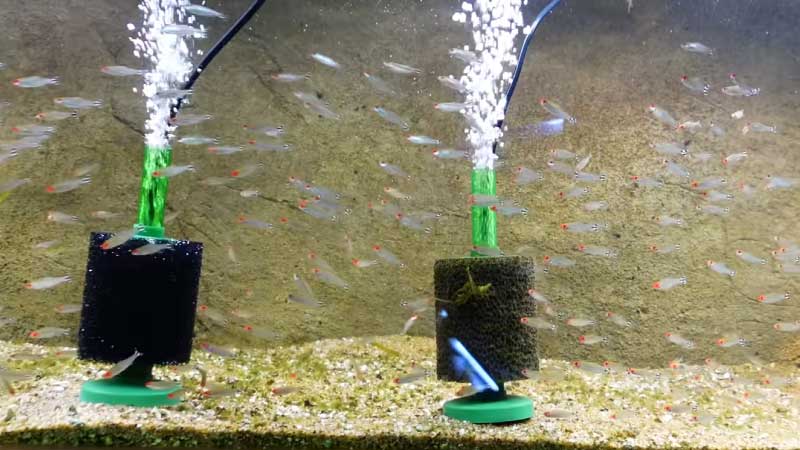Are you tired of replacing sponges every few weeks? How can you improve performance?
The power of your sponge filter depends on its ability to remove waste from your water. However, as it ages, it stops working as well and requires more effort on your part.
In this article, we will discuss how to improve a sponge filter in an fish aquarium. We will talk about what causes these filters to be inefficient and what can be done to make them more efficient.
First, let’s start with the basics.
What is a Sponge Filter?
A sponge filter is a type of filter that uses sponges as its media. It consists of a tank with water on one side and sponges on the other side that is filled with water and provide surface area for bacteria to live on. The bacteria then convert ammonia into nitrite which is then converted into nitrate by plants in the tank. The plants then use nitrate to grow their leaves and roots which provide oxygen for fish in the tank and also help clean up any excess waste from the tank.
Fish tanks are an important part of the aquatic ecosystem. They provide a suitable place for fish to live and grow, but they also need proper care and maintenance. One of the ways that you can improve your sponge filter is by cleaning it regularly.
How to Optimize and Aquarium Filter

Sponge filters are great for removing large amounts of waste from your water, but oftentimes they fall short. Their low performance leaves you unsatisfied with the results. You can use a pair of scissors to make your own reusable filter media.
1. Cut off the old filter cartridge.
The cartridge filters are designed to be used once and thrown away. The best filters are ones that are easy to maintain and clean. Most cartridges are made out of very fine filter padding for mechanical filtering and activated carbon for chemical filtering. Unfortunately, these materials quickly become saturated with waste, and their dense material is difficult to clean and reuse.
2. Insert the new cartridge.
“Coarse sponge filters are reusable filters that can be used multiple times. They can also be used in conjunction with an air pump and airstone.
Mechanical filtration uses coarse sponge pads that don’t clog easily. Biological filtration uses bags of bio rings that allow beneficial bacteria to grow in the filter.
You can also buy a resaleable filter media bag and add the right amount of bio ring that will fit inside the compartment. Bio rings increase the growth of biological bacteria.
To install the filter, you must know how the water flows through the filters. You should place the coarse sponge pad at bottom of the filter compartment (so that the flow of water hits it first).
Then place the bio rings on the sponge. This prevents the coarse sponge from getting dirty too fast.
Bio rings also prevent the fine sponge from clogging up. Nano tanks come with a built-in filtering system. You should use a coarse sponge instead of a disposable cartridge. Disposable cartridges don’t provide enough filtration.
3. Screw the new cartridge onto the base.
Now its time to properly screw the new cartridge into the existing base.
4. Connect the power cord.
And finally don’t forget to connect the new cartridge power cord, see the result.
How to Improve a Sponge Filter in An Aquarium

A sponge filter is a common type of filter used in fish tanks. It is made up of porous material, usually sponges. This filter is usually placed in the tank and it helps to clean the water by absorbing debris and waste.
The sponge filter works by using a pump to circulate water and change its direction so that it can move through the sponges. They are often used on smaller tanks with low filtration needs.
There are three main types of filters: mechanical, chemical, and biological. The sponge filter falls under the category of biological filters because they use living organisms to accomplish their task.
Sponge filters are efficient because they require less maintenance than other types of filters. However, they are not as effective as other types of filters like bio-filtration or mechanical filtration.
The most important tip for increasing sponge filter efficiency is to make sure that the pump is running at a high enough rate so that water from the aquarium or pond can flow through the filter in less than one hour.
We need to understand the sponge filters that are already in use.
The most common type of filter is a mechanical filter. This filter uses a rotating drum that has small spaces on its surface. The water is pulled through the spaces as it flows out of the tank and into the drain pipe.
Why is My Sponge Filter Not Cleaning?

The sponge filter is a popular type of filtration system used in aquariums. The sponge filter is designed to remove waste and debris from the water by trapping it between the porous sponges that are submerged in the aquarium.
The problem with this particular type of filter is that it does not work properly if the sponges are not submerged properly.
This means that you need to make sure that your sponges are always submerged in water so they can do their job effectively.
If your sponge filter becomes clogged, then you will need to replace them with new ones.
If your sponge filter is not cleaning properly, it may be due to a clogged filter. Here are some reasons why your sponge filter may not be working properly:
- The water is too cold.
- The water has a high amount of chlorine in it.
- There is an issue with the pump.
This type of filter is not very efficient and needs frequent cleaning, which means that it needs regular maintenance.
What are the Maintenance of the Aquarium Sponge Filters?
The aquarium sponge filter is a type of filter that is commonly used in the aquarium. It consists of a bag-like container with a porous material. The porous material traps the excess water and debris and releases clean water into the aquarium.
Sponges are made up of three layers: an outer layer of coarse mesh, an inner layer of finer mesh, and a middle layer that is mainly made up to release oxygen. These three layers work together to maintain the aquarium’s healthy ecosystem.
Sponges contain bacteria that help break down waste in the water and release oxygen into it. They also remove carbon dioxide from the water which helps keep it clear for fish to see their surroundings.
Ammonia, nitrites, and nitrates are toxic substances in aquarium filters. They can cause stress to fish and other aquatic life.
Aquarium sponge filters are made up of a filter bag, a filter pad, and an air pump. The filter bag is used to hold the water that is filtered out of the tank while the air pump pushes the water through the filter pad. The filter pad traps any impurities or toxins that come through while also providing oxygen to help with respiration.
The maintenance process for this type of aquarium is relatively easy as it only requires cleaning the filter bag every few weeks or when necessary.
Frequently Asked Questions
Can you put filter media in a sponge filter?
The sponge filter is a common household appliance that can be used to filter water and remove impurities from it. It consists of a porous material that can hold large amounts of water. The filter media is made of polyester or polypropylene, and it is designed to remove the dirt particles from the water by trapping them on the surface of the sponge.
How do you reduce the flow of a sponge filter?
A sponge filter is an excellent way to reduce the flow of a sewage system, but it requires regular cleaning. The best way to clean a sponge filter is by using water. The more water that goes through the filter, the cleaner its inside becomes.
To clean your sponge filter, you will need to empty out the tank and use a bucket or plunger to suck up all of the water that has accumulated on top of it. You can then use a garden hose to rinse off any debris that has been left behind and re-fill the tank with freshwater.
In order to reduce your sponge filter’s flow rate, you will need to remove any vegetation from around it and make sure there are no leaves or other debris in or around it.
Which Sponge Filter Do You Recommend?
Sponge filters are pretty basic pieces of equipment, so there’s not a lot of difference among brands. After a decade of using sponge filters, we made ours with all the improvements and features that we’ve always wanted.
1. Sponge filters are used to filter out particles from the water.
2. Sponges are porous materials that allow water to pass through them.
3. You can use multiple sponges to increase the amount of water filtered at once.
4. A sponge filter does not require electricity to operate.
5. Sponge filters do not clog up as fast as other types of filters.
6. Sponge filters don’t contain any chemicals.
7. Sponge filters are easy to maintain.
8. Sponge filters are inexpensive.
9. Sponge filters are very effective.
10. Sponge filters are environmentally friendly.

I’m an aquatic veterinarian have a love for aquarium fish. The purpose of creating this blog is to share my personal experience and expertise with the most popular Betta Fish as well as other fish. If you are, interested in caring for Betta fish species just like me? Follow my articles and guides.
